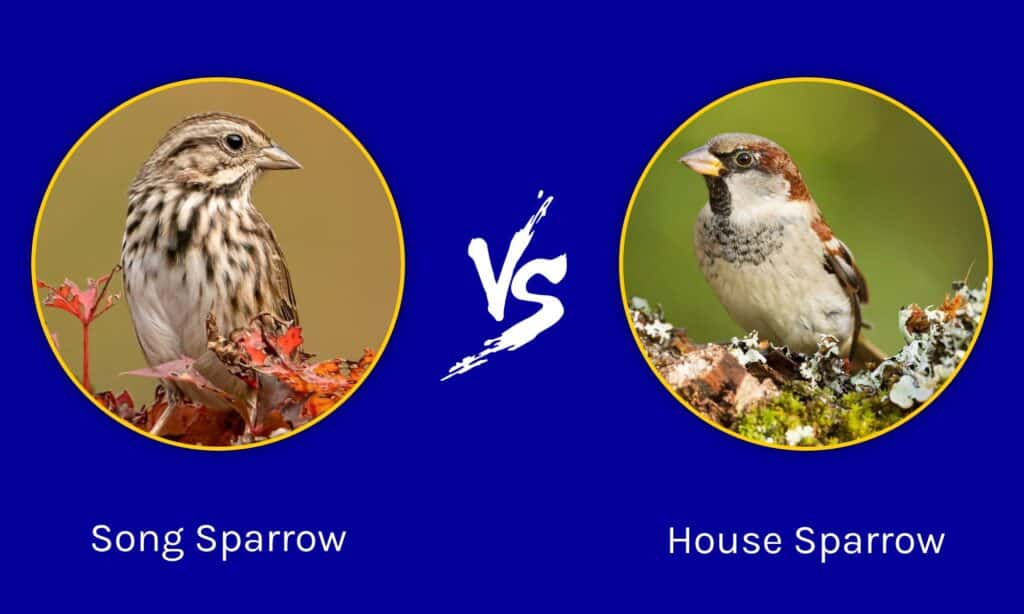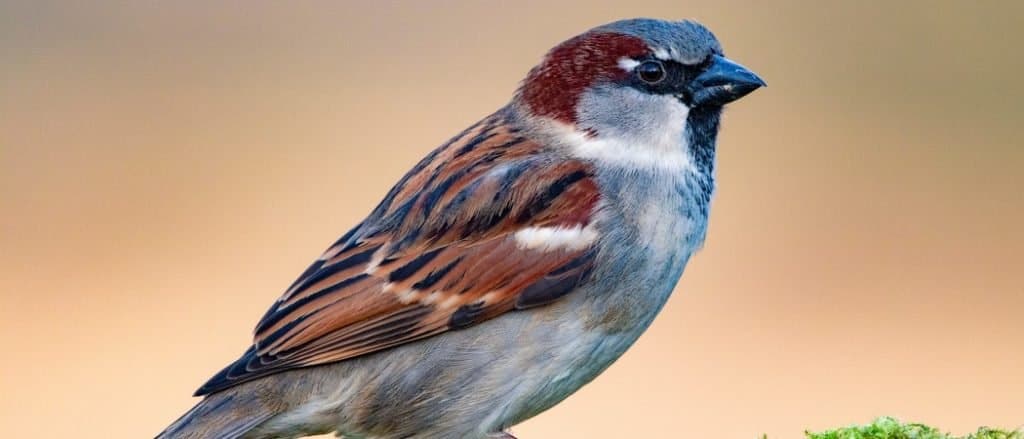Sparrows are active, small birds comprising many different species. Because this species is so abundant, the various sparrows can be challenging to identify. Therefore, this article compares the differences between these birds, focusing on specific features in the song sparrow vs. house sparrow table below.

Comparing Song Sparrow vs. House Sparrow
| Song Sparrow | House Sparrow | |
| Scientific Name | Melospiza melodia | Passer domesticus |
| Habitat | Open Woodlands, North America | Towns, North America |
| Diet | Insectivorous | Omnivorous |
| Nesting | Will nest in shrubs | Will nest in cavities |
| Behavior | Ground forager | Ground forager |
| Conservation status | Least concern | Least concern |
Song Sparrow vs. House Sparrow: Description
The Song Sparrow is a small bird widely spread throughout North America. It has richly colored russet and gray feathers, with bold black streaks on its white chest. Song sparrows live in open shrubby areas, and males sing happily and prolifically.
Song Sparrows are native to most North American States. However, song sparrows found in different areas look very different from one another. Song Sparrows breed in the spring and summer.
House sparrows are small birds that are spread throughout North and South America. Their feathers are shades of brown and grey, and the sexes are easily identified as the males have bolder colors.
House sparrows tend to be aggressive little birds and often chase away other garden birds. House sparrows prefer to live near humans. They will often build nests in tree hollows and nooks and crannies in walls or inside roof eaves.

Song sparrow vs house sparrow: The male house sparrow has brighter feathers than the females. Song sparrows in different areas also look different from each other but sound the same.
©Craig Howman/Shutterstock.com
Diet
Song sparrows are insectivores, so they eat all kinds of insects, including beetles, caterpillars, wasps, and ants. During the winter months, they will feed on grass and weed seeds. These birds are also ground foragers, meaning they hop around on the ground and consume whatever they can find. In addition, they will even eat some fruits.
House sparrows eat seeds and grains primarily. They will feed on crops, discarded food in cities, and livestock feed. Birdseed is another favorite meal for these birds, which have a strange tendency to steal food from other birds. They also habitually take over areas and chase away native birds. House sparrows are opportunistic feeders and will eat any available food they can find.
Nesting and Breeding Behavior
Males vigorously court female song sparrows. Once a pair has developed a relationship, they look for a suitable nesting location together. Their idea of an appropriate location is in shrubs or on the ground beneath clumps of grass, with nests typically being low to the ground. Females lay clutches of four to six eggs. Both males and females sit on the eggs to incubate them, with both parents caring for the nestlings.
House sparrows usually mate for life and build their nests from plants and other available materials. Females lay clutches of four to eight eggs, and both parents take turns sitting on the eggs to incubate them. Once they hatch, both parents look after the nestlings, feeding them and teaching them to forage and fly.
Song Sparrow: Behavior
Song sparrows are very territorial birds, creating their homes in a large array of habitats. However, they tend to prefer areas near the water with an abundance of shrubs. They are migratory in the northern parts of the USA. These birds are defensive of their territory when they live there year-round, and territorial boundaries are stable. Both males and females play a defensive role. However, females can be more defensive than their male counterparts.
Additionally, song sparrows tend to mate for life. In this species, females are the nest builders, using diverse nesting materials to make their nests which are extensive and well hidden in large shrubs.
Song sparrows from different areas look quite different from each other. For example, some are larger than others, while some may have darker or lighter-colored feathers. However, all song sparrows have one thing in common: their song always sounds the same, no matter the area.

A song sparrow builds its nest on or close to the ground in shrubs, using various materials.
©iStock.com/JackVandenHeuvel
House Sparrow: Behavior
These sparrows are friendly and social little birds that feed in large groups. House sparrows are thought to have originated in the Mediterranean and been introduced through human intervention.
These small birds also mate for life, but they will quickly replace a lost mate. Males build nests in suitable areas and vigorously defend the immediate site of the nest. Moreover, male house sparrows actively pursue females, with a few males competing for her attention. Mating usually occurs a few times during the breeding cycle. Pairs may raise up to four broods during one breeding season.
Both male and female house sparrows will build their nest in any available and suitable space. However, these birds prefer to nest near or where people live. They use many materials to create their untidy nests. You may see these nests in tree hollows and occasionally under house eaves. Modern houses have fewer potential entrances for them to build their nests. House sparrows live in one nest year-round. During the summer, they use the nest to raise their babies and to rest during winter and fall.
House sparrows take frequent dust baths to control parasites. They lie down in a small hole in the ground and wiggle around, throwing dust on their bodies.
House sparrows were introduced to the USA during the mid-1800s to help control pests. Unfortunately, they are aggressive towards native birds like the bluebird, chickadee, and wren. House sparrows will actively chase these native birds from nesting boxes and areas.
Song Sparrow vs House Sparrow: Are They Pests?
Song sparrows are not considered pests. They live in specific areas in the U.S. They will defend their territory but won’t chase other birds away from nesting or feeding sites.
House sparrows are considered pests in the U.S. They have no known natural predators, although cats, owls, and hawks will catch them. They tend to breed more than native species and will kill nestlings and birds to claim nesting spaces.
The photo featured at the top of this post is © fewerton/Shutterstock.com
Thank you for reading! Have some feedback for us? Contact the AZ Animals editorial team.






